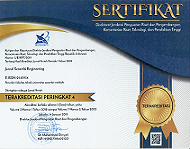Evaluation of the Triggering Activity of Community-Led Total Sanitation to Eradicate Open Defecation in Nagari Tiku Utara, Agam Regency
Keywords:
CLTS, community, open defecation, sanitation, triggeringAbstract
Open defecation (OD) is a form of poor sanitation. OD can affect environmental health and public health. Community-led Total Sanitation (CLTS) is an approach that can be used to change community behavior by fostering a sense of disgust and shame towards OD practices so that the community can stop OD practices. This study is a form of CLTS triggering activity to eradicate OD in Nagari Tiku Utara. Evaluation of CLTS triggering activities was carried out to obtain community feedback after receiving triggering activities. This study was divided into several stages in the form of literature studies, procurement of triggering activity related to the eradication of OD practices, implementation of evaluation of triggering activity for the eradication of OD practices that have been carried out, and data analysis. Evaluation of the triggering activity was carried out using interviews and filling out questionnaires. The number of respondent samples taken was as many as the number of residents who attended the triggering activity related to the practice of eradicating OD in Nagari Tiku Utara, namely a sample of 30 respondents. The results of this study showed that the four components assessed after the triggering activities, namely community knowledge, community behavior, safe latrines components, and latrines observations, actually achieved achievements ranging from very good to sufficient.
References
[1] A. Sumantri, Kesehatan Lingkungan., Keempat. Depok: Kencana, 2023.
[2] D. Ermayendri, “Pengaruh CLTS (pemicuan) untuk meningkatkan akses jamban (pilar pertama STBM di Kabupaten Bengkulu Selatan,” J. Nurs. Public Heal., vol. 5, no. 2, pp. 14–18, 2017.
[3] N. N. S. N. Sudhiastiningsih, T. Agustina, and C. R. Priadi, “Analysis of water, sanitation, and hygiene (WASH) implementation based on GEDSI and climate resilience in Kupang City,” E3S Web Conf., vol. 485, 2024, doi: 10.1051/e3sconf/202448504001.
[4] J. Novotný, J. Hasman, M. Lepič, and V. Bořil, “PROTOCOL: Community‐led total sanitation in rural areas of low‐ and middle‐income countries: a systematic review of evidence on effects and influencing factors,” Campbell Syst. Rev., vol. 14, no. 1, pp. 1–27, 2018, doi: 10.1002/cl2.188.
[5] N. E. Soboksa, S. R. Gari, A. B. Hailu, and B. M. Alemu, “Child defecation, feces disposal practices and associated factors in community-led total sanitation adopted districts in Jimma Zone, Ethiopia,” Environ. Challenges, vol. 3, no. January, p. 100059, 2021, doi: 10.1016/j.envc.2021.100059.
[6] H. A. A. Kouassi et al., “Review of the slippage factors from open defecation-free (ODF) status towards open defecation (OD) after the Community-Led Total Sanitation (CLTS) approach implementation,” Int. J. Hyg. Environ. Health, vol. 250, no. March, 2023, doi: 10.1016/j.ijheh.2023.114160.
[7] Ministry of Health Uganda, Community Led Total Sanitation in Uganda. A handbook on Facts and Processes, no. October 2012. 2012. [Online]. Available: https://www.communityledtotalsanitation.org/country/afghanistan
[8] K. Kar and R. Chambers, Handbook on Community-Led Total Sanitation, vol. 44, no. 0. London: Institute of Development Studies, 2008.
[9] S. Arikunto, Prosedur penelitian suatu pendekatan praktik. Jakarta: Rineka Cipta, 2006.
[10] BPS Kabupaten Agam, Kecamatan Tanjung Mutiara Dalam Angka 2024. Lubuk Basung: BPS Kabupaten Agam, 2024.
[11] Mundiatun, Daryanto, and A. Suprihatin, “Pengelolaan Kesehatan Lingkungan,” 2015, Gava Media, Yogyakarta.
[12] S. Rejeki, Sanitasi, Hygiene, dan Kesehatan & Keselamatan Kerja (K3). Bandung: Rekayasa Sains, 2015.
[13] Zulkarnaini and B. V. Wemas, “Pemicuan Community Led Total Sanitation di Jorong Lubukk Koto, Nagari Sialang, Kecamatan Kapur IX, Kabupaten 50 Kota,” War. Pengabdi. Andalas, vol. 30, no. 3, pp. 480–491, 2023, [Online]. Available: http://wartaandalas.lppm.unand.ac.id/index.php/jwa/article/view/943
[14] C. Leong, “Narratives of sanitation: Motivating toilet use in India,” Geoforum, vol. 111, no. October 2019, pp. 24–38, 2020, doi: 10.1016/j.geoforum.2019.10.001.
[15] V. Zuin, C. Delaire, R. Peletz, A. Cock-Esteb, R. Khush, and J. Albert, “Policy Diffusion in the Rural Sanitation Sector: Lessons from Community-Led Total Sanitation (CLTS),” World Dev., vol. 124, 2019, doi: 10.1016/j.worlddev.2019.104643.
[16] M. Harter, J. Inauen, and H. J. Mosler, “How does Community-Led Total Sanitation (CLTS) promote latrine construction, and can it be improved? A cluster-randomized controlled trial in Ghana,” Soc. Sci. Med., vol. 245, no. December 2019, 2020, doi: 10.1016/j.socscimed.2019.112705.
[17] D. A. Zeleke, K. A. Gelaye, and F. A. Mekonnen, “Community-Led Total Sanitation and the rate of latrine ownership,” BMC Res. Notes, vol. 12, no. 1, pp. 10–14, 2019, doi: 10.1186/s13104-019-4066-x.
[18] N. Eshete, A. Beyene, and T. Gudina, “Implementation of Community-led Total Sanitation and Hygiene Approach on the Prevention of Diarrheal Disease in Kersa District, Jimma Zone Ethiopia,” Sci. J. Public Heal., vol. 3, no. 5, p. 669, 2015, doi: 10.11648/j.sjph.20150305.22.
[19] W. Asrate, A. Admasie, and T. Shibabaw, “Households’ access to an improved latrine and its associated factors among households of sanitation marketing products users and non-users, Northeast Amhara, Ethiopia,” Heliyon, vol. 8, no. 11, 2022, doi: 10.1016/j.heliyon.2022.e11325.
[20] T. K. Soe and K. K. Nyein, “Social Disparities And Accessibility Of Sanitation Marketing Factors Among Rural Community Of Myinmu Township: A Cross Sectional Analytical Study,” no. June 2020, p., 2023.
[21] E. Siti, I. Masni, J. Sianipar, A. Rahman, and I. W. Koko, “Advancing the 2030 agenda with community importance-performance perspective and public relations strategies for community-based sanitation,” vol. 9, no. April, 2025.
[22] M. Harter, N. Contzen, and J. Inauen, “The role of social identification for achieving an open-defecation free environment: A cluster-randomized, controlled trial of Community-Led Total Sanitation in Ghana,” J. Environ. Psychol., vol. 66, no. December 2018, 2019, doi: 10.1016/j.jenvp.2019.101360.
[23] E. Adam and E. Badu, “Community-led total sanitation (CLTS) implementation in West Mamprusi Municipal Assembly in Ghana. What do communities think eleven years on?,” Glob. Heal. J., vol. 8, no. 2, pp. 67–73, 2024, doi: 10.1016/j.glohj.2024.05.003.
[24] J. Tribbe, V. Zuin, C. Delaire, R. Khush, and R. Peletz, “How do rural communities sustain sanitation gains? Qualitative comparative analyses of community-led approaches in cambodia and ghana,” Sustain., vol. 13, no. 10, 2021, doi: 10.3390/su13105440.
Downloads
Published
Issue
Section
License
Copyright (c) 2025 Dewi Yusnisa Putri (Author)

This work is licensed under a Creative Commons Attribution 4.0 International License.












